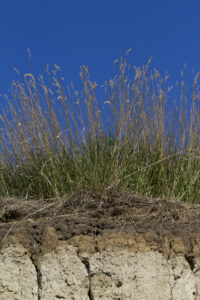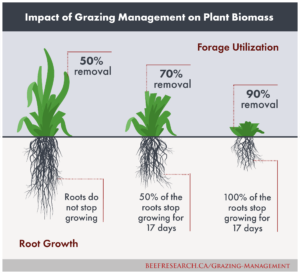Icebergs and Native Forages - What You Can’t See Can Sink You 🎙️
CLICK THE PLAY BUTTON TO LISTEN TO THIS POST:
Listen to more episodes on BeefResearch.ca, Spotify, Apple Podcasts, Amazon Music or Podbean.
This article written by Dr. Reynold Bergen, BCRC Science Director, originally appeared in the April 2025 issue of Canadian Cattlemen magazine and is reprinted on BeefResearch.ca with permission of the publisher.
In April 1912, the RMS Titanic sank off the coast of Newfoundland after an iceberg tore a hole in her hull 25 feet below the waterline. Only a tenth of an iceberg is visible above the water; most of it lurks beneath the surface. Forage plants are similar: how things look on the soil surface may not reflect what’s happening further down.
Forages use sunlight to convert carbon dioxide into plant sugars that drive plant growth. They can only do this if the roots can absorb enough water and minerals from the soil. You’ve probably seen old pictures of a healthy grass plant with enormous roots extending deep into the soil, and overgrazed grass plants with shallow root systems.
With drought a recurring reality in many regions, you might wonder what affects pastures more – the drought or overgrazing during drought? Dr. James Cahill and co-workers at the University of Alberta studied how grazing season and intensity affected forage yield and root mass under drought conditions (Differential sensitivity of above- and belowground plant biomass to drought and defoliation in temperate grasslands; https://doi.org/10.1016/j.agee.2023.108660).
What They Did
This team collected data at seven predominantly native grassland sites in Alberta representing a range of average annual precipitations (Gem, 312mm; Onefour, 318mm; Oyen, 321mm; Twin River, 358mm; Kinsella, 401mm; Sangudo, 492mm; Stavely, 533mm). Extreme drought was imposed by installing transparent rainout shelters over half the plots to divert nearly half of the precipitation during the growing season. Plots were clipped instead of grazing, because cattle would have demolished these shelters.
Five different clipping treatments were designed to represent different grazing intensities and timings. The control treatment remained unclipped in June and September (None/None). The Heavy/None treatment was clipped heavily in June (to 3cm stubble height) but not in September. The None/Heavy treatment was not clipped in June but heavily clipped to 3cm in September. The Light/Heavy treatment was clipped to a 7cm stubble height in June and 3cm in September to mimic light early-season grazing followed by heavier grazing after vegetation growth slows. The Heavy/Heavy treatment was clipped to a 3cm stubble height in both June and September.
The combination of two rainfall treatments and five clipping treatments allowed them to test grassland responses to 10 different grazing management and moisture scenarios. Each of these 10 combinations was replicated four or five times at each site. Treatments were imposed during the 2017, 2018 and 2019 growing seasons.
After three years, total above-ground forage production was measured by harvesting a portion of each plot to ground level in July, and 15cm deep soil cores were collected to measure root mass.
What They Learned
During the three years of the experiment, natural rainfall was consistently lower than normal at the driest sites (Gem, Onefour, Oyen and Twin River) but above normal in at least one out of three years at the Kinsella, Sangudo and Stavely sites. The rainout shelters imposed historically harsh or near record drought conditions at all sites.
Effects of drought: Extreme and prolonged drought did not significantly reduce forage productivity or root mass on its own. Native grasses are adapted to the environmental challenges that nature brings.
Effects of heavy grazing in spring vs. fall: Clipping plots heavily once in June did not affect forage yield compared to a single heavy defoliation in September regardless of moisture, but early clipping was more harmful to the roots, particularly under drought conditions. The Heavy/None treatment reduced root biomass by 8% under normal rainfall and by 16% under extreme drought. This supports long-standing recommendations to avoid grazing native grasslands heavily, particularly early in the year.
Effects of increasingly heavy spring clipping: As June clipping intensity increased from None/Heavy to Heavy/Heavy, forage yields declined by 15% under both normal and drought conditions. Root biomass responded similarly, decreasing by up to 23% under extreme drought.
Location effects: Drought had consistent effects on root biomass regardless of how much precipitation each study site received. However, the additive effects of clipping during drought affected root biomass differently among sites. More severe clipping (especially in spring) damaged root growth the most when drought was imposed on grasslands with greater normal rainfall (Kinsella, Sangudo and Stavely).
So, What Does This Mean to You?
Heavy grazing may not depress forage productivity at first. But as roots shrink in size and depth, especially from spring grazing, plants gradually take up less water and nutrients. This will reduce their long-term ability to support above-ground forage growth.

Remember that it may take pastures some time to recover from being grazed through repeated years of severe drought. To regrow lost roots, plants need to transfer energy from shoots into roots. But they can only do this if they have enough leaves to begin with! That’s why heavy, early-season grazing should be avoided.
The finding that forages acclimated to higher rainfall areas may be more susceptible to heavy grazing during drought is important for Canada’s wetter regions. Grasslands may be less adapted to drought in regions where drought is less common, and more heavily impacted when it occurs. A moderate drought in a region that normally sees more rainfall may be more damaging than a moderate drought in a normally dry region. Careful grazing management is important everywhere, regardless of what “normal” rainfall looks like.
Bottom Line
While native plants can tolerate significant drought, they can’t tolerate heavy grazing under drought, especially in spring. Neglecting what’s below the surface can get you into trouble with both forages and icebergs.
The Beef Cattle Research Council is a not-for-profit industry organization funded by the Canadian Beef Cattle Check-Off. The BCRC partners with Agriculture and Agri-Food Canada, provincial beef industry groups and governments to advance research and technology transfer supporting the Canadian beef industry’s vision to be recognized as a preferred supplier of healthy, high-quality beef, cattle, and genetics. Learn more about the BCRC at www.beefresearch.ca.
Click here to subscribe to the BCRC Blog and receive email notifications when new content is posted.
The sharing or reprinting of BCRC Blog articles is typically welcome and encouraged, however this article requires permission of the original publisher.
We welcome your questions, comments and suggestions. Contact us directly or generate public discussion by posting your thoughts below.
